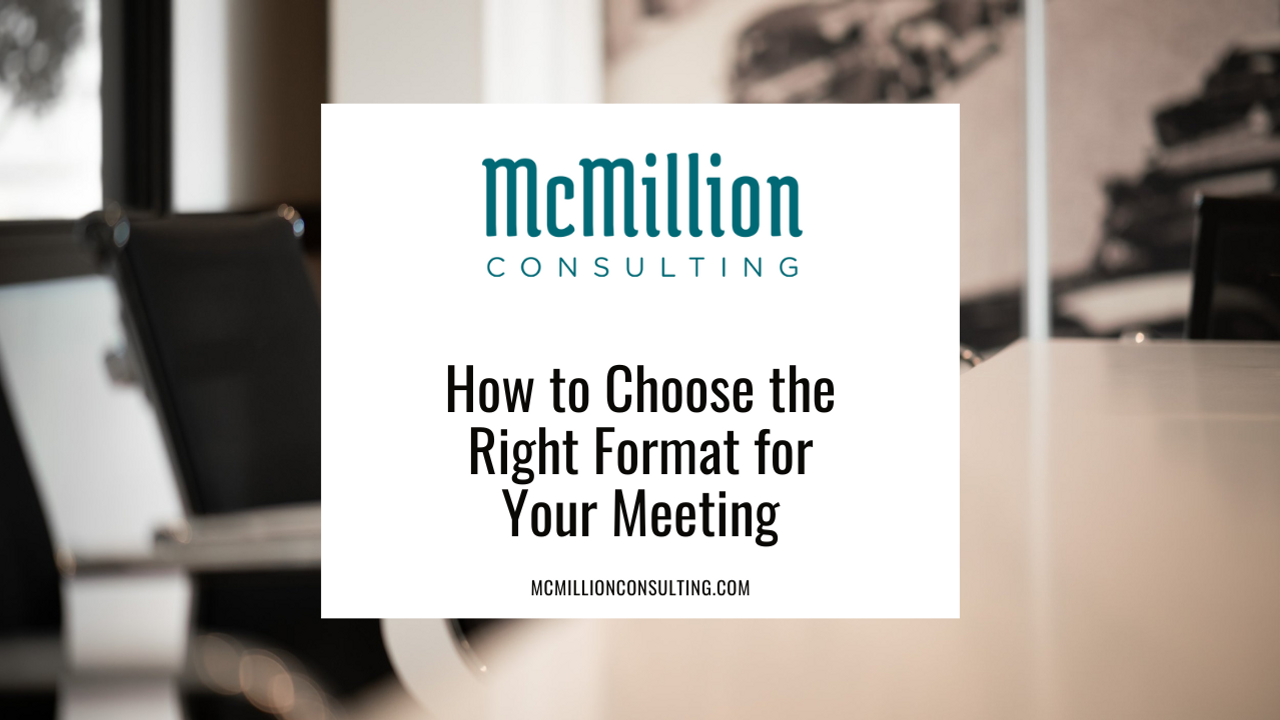How to Choose the Right Format for Your Meeting
Jun 28, 2022
Since the pandemic, most of us have become quite accustomed to alternative meeting formats, whether that’s a phone call, a video call, or a good old fashioned face-to-face conversation. At this point, we’ve all slid into meeting norms—weekly Zoom check-ins, team conference calls, etc. The conversations many teams were once having around which format or which platform to use have largely faded as many companies have settled into their new standard operating procedures around remote or hybrid work.
While I understand the benefits of routine, I’ve come to believe that there is value in avoiding a one-size-fits-all approach for meetings. In fact, I’ve been surprised at the positive response when I have intentionally opted for a phone call over a video or a face-to-face conversation instead of an email. (Keep reading to find out what happened!) Often, there’s no “right” answer, but there are compelling reasons to select one format over another. If you have the flexibility to choose the medium for your meeting, keep the following pros and cons of each format option in mind.
Phone Call:
Just because you can choose a video over a phone call doesn’t always mean you should. In fact, there’s compelling research to suggest that so-called “Zoom fatigue” does in fact exist. Staring at a grid of digital faces (including your own) can quickly tax your mind.
Recently, I connected with a client over an audio-only call, rather than a video call. She immediately expressed her relief when she realized we’d be “cameras off.” Her calendar had become so stacked with video calls that a phone call felt like a welcome break.
You might consider a phone call when:
- You want a break from “Zoom fatigue”
- You need more flexibility to connect on-the-go
- You want to reduce the burden of being “camera-ready”
- You already have an established relationship with the participant(s)
- You’re connecting 1-on-1 and won’t need to distinguish between multiple voices
- Your conversation requires attentive listening
Video:
The past several years have really put a spotlight on the power of video calls for remote collaboration. Many say a video call is the next best thing to being in person, and I tend to agree. Video calls can provide enough connection to build a professional rapport without ever stepping foot in the same room.
Throughout the pandemic, I was so grateful to be able to continue teaching, training, and speaking to groups via video. In fact, long before the COVID, I was regularly using video calls to make my training and consulting services available to clients all across the country. While it’s not always my first choice, there are many situations when a video call is the perfect fit.
You might consider a video call when:
- You need screen-sharing capabilities
- Your meeting involves multiple people
- You’ve never met your meeting participants before and want to put faces to names
- You’re teaching, training, or speaking to a group
- You want to establish a personal connection
- You’d like to be able to read body language
- You’re trying to build team comradery
Face-to-Face:
Technology can only go so far. Nothing beats meeting in the same space face-to-face. I usually reserve in-person meetings for longer, more relationship-oriented matters. For instance, a team summit, multi-day onsite training, or an unrushed catch-up with a mentor are all situations that lend themselves well to an in-person format.
While face-to-face conversations can be immensely powerful, I recommend scheduling them sparingly. Even pre-pandemic, defaulting to a face-to-face format for every meeting was impractical. Of all the options, a face-to-face meeting is typically the biggest time commitment. Usually, you’ll need to factor in time for a commute to and from the meeting and other logistics like coffee or a meal, depending on the style of your gathering. For me, it’s often more efficient to use phone calls and video calls for time-sensitive or informational meetings.
You might consider a face-to-face conversation when:
- You need to solidify an important relationship
- You’re selling something physical that’s best experienced in real life
- You’re in the final phases of interviewing a candidate for a job opening
- You want to create a memorable experience
- You’ve already accomplished as much as you can via digital formats
- You happen to be traveling in an area near a client or partner
- You want to express your thanks by buying a meal or coffee for someone
The Wrap-Up:
Bottom line, your meeting format deserves a second thought. Before you block off time on your colleagues calendars for an hour-long video call, consider: What do we need to accomplish? What does my team need and want right now? How can we achieve our goals as efficiently and effectively as possible?
I’m constantly amazed how much can be achieved simply by rethinking the status quo. Growing your influence doesn’t have to involve a dramatic change. Often, it requires a series of small changes taken together. Whenever I uncover an unexpected insight, I’ll be the first to share it with you here on LinkedInsider. If you’re not already a subscriber, sign up here to receive access to my weekly articles which are aimed at helping you make a bigger impact, both on and off LinkedIn.



